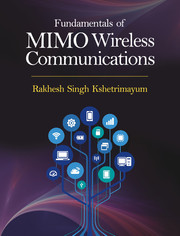Book contents
- Frontmatter
- Dedication
- Contents
- Figures
- Tables
- Preface
- Acknowledgments
- Abbreviations
- 1 Introduction to MIMO Systems
- 2 Classical and Generalized Fading Distributions
- 3 Analytical MIMO Channel Models
- 4 Power Allocation in MIMO Systems
- 5 Channel Capacity of Simplified MIMO Channels
- 6 MIMO Channel Capacity
- 7 Introduction to Space-Time Codes
- 8 Space-Time Block and Trellis Codes
- 9 Introduction to MIMO Detection
- 10 Advanced MIMO Detection Techniques
- 11 Antenna Selection and Spatial Modulation
- 12 Advanced Topics in MIMO Wireless Communications
- Appendix A Matrices
- Appendix B MGF of Hermitian Quadratic Form in Complex Gaussian Variate
- Appendix C Basics of Information Theory
- Appendix D Basics of Convolutional Codes
- Appendix E Basics of Turbo Codes
- Appendix F Algebraic Structures
- Appendix G An Introduction to Game Theory
- Index
11 - Antenna Selection and Spatial Modulation
Published online by Cambridge University Press: 23 July 2017
- Frontmatter
- Dedication
- Contents
- Figures
- Tables
- Preface
- Acknowledgments
- Abbreviations
- 1 Introduction to MIMO Systems
- 2 Classical and Generalized Fading Distributions
- 3 Analytical MIMO Channel Models
- 4 Power Allocation in MIMO Systems
- 5 Channel Capacity of Simplified MIMO Channels
- 6 MIMO Channel Capacity
- 7 Introduction to Space-Time Codes
- 8 Space-Time Block and Trellis Codes
- 9 Introduction to MIMO Detection
- 10 Advanced MIMO Detection Techniques
- 11 Antenna Selection and Spatial Modulation
- 12 Advanced Topics in MIMO Wireless Communications
- Appendix A Matrices
- Appendix B MGF of Hermitian Quadratic Form in Complex Gaussian Variate
- Appendix C Basics of Information Theory
- Appendix D Basics of Convolutional Codes
- Appendix E Basics of Turbo Codes
- Appendix F Algebraic Structures
- Appendix G An Introduction to Game Theory
- Index
Summary
Introduction
Multiple-input multiple-output (MIMO) systems’ capacity increases and the bit error rate minimizes with the number of antennas as compared to single-input single-output (SISO) system. But, they have higher fabrication cost and energy consumption due to multiple radio frequency (RF) chains. An RF chain usually has low noise amplifier, frequency converters, analog–digital and digital–analog converters, filters, etc. A dedicated RF chain is needed for every antenna which makes implementation cost and hardware complexity higher. Antenna selection minimizes this by using lesser number of RF chains and by connecting selected antennas with RF chains with the help of switches. Select the best set of antennas at the transmitter or receiver so as to maximize the channel capacity or received signal-to-noise ratio (SNR). In the next section, we will discuss about the transmit antenna selection (also called as hard antenna selection) over fading channels. Then we will discuss about the soft antenna selection for closely spaced antennas. Then we will briefly discuss about spatial modulation and combine spatial modulation with antenna selection. In spatial modulation, there are two information bearing units: (a) Transmit antenna index and (b) Symbol from signal constellation, which is transmitted from antenna corresponding to the selected transmit antenna index. It is a relatively new MIMO technique, which was proposed R. Mesleh et al. (2008). Some of the advantages are (a) higher capacity (b) reduced hardware complexity and (c) avoidance of transmit antenna synchronization. One of the problems with spatial modulation is that the link for the selected antenna may be down, and then the performance of the spatial modulation is worst. In order to overcome this, one can do antenna selection before applying spatial modulation. Select a subset of antenna with the best links and apply spatial modulation on those selected antennas. As reported by B. Kumbhani et al., (2014), there is significant performance improvement in MIMO systems which combine antenna selection with spatial modulation.
Transmit antenna selection (TAS) over fading channels
We have considered a MIMO system with only one RF chain at the transmitter as depicted in Fig. 11.1. This kind of antenna selection is also called as hard antenna selection.
- Type
- Chapter
- Information
- Fundamentals of MIMO Wireless Communications , pp. 245 - 269Publisher: Cambridge University PressPrint publication year: 2017



